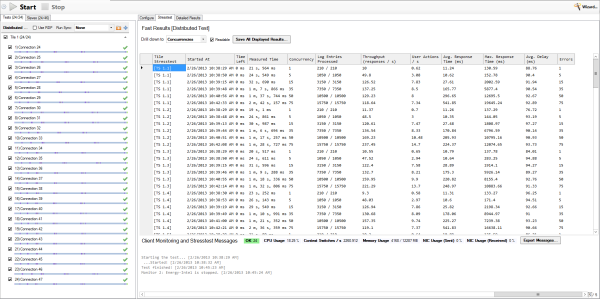Calxeda's ARM server tested
by Johan De Gelas on March 12, 2013 7:14 PM EST- Posted in
- IT Computing
- Arm
- Xeon
- Boston
- Calxeda
- server
- Enterprise CPUs
Our Real World Test
We've set up two systems, the Xeon system with two different pairs of Xeon CPUs, 128GB and ESXi 5.1. We created 24 virtual machines on top of the Xeon server. Inside each we have a PhpBB (Apache2, MySQL) website with four virtual CPUs and 4GB RAM. The website uses about 8GB of disk space. We simulate up to 75 concurrent users that send new requests every 0.6-2.4 seconds.
The Boston Viridis server gets the same workload, but instead of using virtual machines, we used the 24 physical server nodes.
Since the redesign in late 2010, our vApus stresstesting framework is well suited to hit (virtualized or not) clusters with lots of workloads in parallel. A quad 7400 server is able to spawn 24 testing clients. The server is connected to our Dell PowerConnect 8024F (10Gbit Ethernet), which is connected to the testservers.
vApus hitting 24 web servers in parallel
This way we can simulate a webhosting environment where tens of websites are hit by a few thousands of visitors per second. That might not sound very impressive, but those few thousand requests per second result in a web environment with 100 million hits per day.
Since we made sure that our web server serves up some nice pictures (png), there is some significant network traffic going on. We measured peaks of up to 8Gbit/s, with typical network traffic being about 4 to 6Gbit/s.











99 Comments
View All Comments
JohanAnandtech - Wednesday, March 13, 2013 - link
Hmmm ... There is almost no info on how that hypervisor works. It is hard to imagine that kind of system would scale very well. How does it keep Cache coherent? Do you have info on that?timbuktu - Wednesday, March 13, 2013 - link
I can't speak directly to ScaleMP, but it looks similar to NUMALink.http://en.wikipedia.org/wiki/NUMAlink
Reading through this article about Calxedas, great job BTW, I couldn't help but think about the old SGI hardware that seemed pretty similar with MIPs (and later Itanium) processors connected through a switch with NUMALink. I haven't played with NUMALink directly in almost a decade, but back then cheaper Altix slabs were ring topology while higher end hardware was switched. In the end though, you could put together a bunch of 1U racks together and have a single system image. Like you mentioned though, cache coherency was exceptionally important. Since we have a uv here, I can point you to the documentation for that box.
http://techpubs.sgi.com/library/tpl/cgi-bin/getdoc...
Everything old is new again, I suppose. Well, except NUMAlink never went away. =D
Tunrip - Wednesday, March 13, 2013 - link
I'd be interested in knowing how the Xeon compared if you did the same test without the virtual machines.JohanAnandtech - Wednesday, March 13, 2013 - link
The website won't scale to 32 logical cores I am afraid... but we can try to see how far we can getColin1497 - Wednesday, March 13, 2013 - link
A better question might be "is 24 VM's a logical number to use?" Would more or fewer VM's work better? The appearance is that you have 24VM's because you have 24 ARM nodes?duploxxx - Wednesday, March 13, 2013 - link
very interesting, loved reading it. But although early in the ball game I do think there are other way better solutions in the pipe-line from the big OEM:HP Moonshot
http://h17007.www1.hp.com/us/en/iss/110111.aspx
JohanAnandtech - Wednesday, March 13, 2013 - link
Isn't remarkable how PR people manage to fill so many pages with "extreme" and "the future" without telling anything. Frustation became even higher when I clicked "get the facts" page. That is more like "You are not getting any facts at all".DuckieHo - Wednesday, March 13, 2013 - link
Since these are set up as webservers, what's the power consumption at say 20-40% load? Usually there is some load instead of completely idle.JohanAnandtech - Wednesday, March 13, 2013 - link
Good suggestion... you'll like to see a step by step power measurement like SpecPower right? Let me try that.DanNeely - Wednesday, March 13, 2013 - link
I'd be interested in seeing where, and what happens when you start pushing single chips to and slightly beyond their limits. Calxeda's hardware's proved competitive on a very friendly workload (which I didn't really expect would happen until their A15 product); but in the real world a set of small websites are unlikely to all have equal load levels. Virtual servers on larger CPUs should give more headroom for load spikes; so knowing what the limits on Calxeda's hardware are strikes me as fairly important.